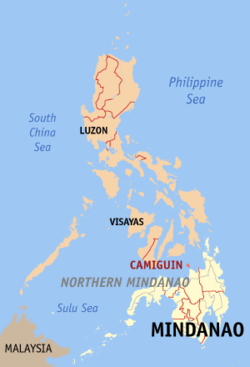Camiguin
| Camiguin | |||
|---|---|---|---|
| Province | |||
| Province of Camiguin | |||

Mount Hibok-Hibok as seen from White Island
|
|||
|
|||
| Motto: The Island Born of Fire | |||
 Location in the Philippines |
|||
| Coordinates: 9°10′N 124°43′E / 9.17°N 124.72°ECoordinates: 9°10′N 124°43′E / 9.17°N 124.72°E | |||
| Country | Philippines | ||
| Region | Northern Mindanao (Region X) | ||
| Founded | 1565 | ||
| Provincehood | June 18, 1966 | ||
| Capital | Mambajao | ||
| Government | |||
| • Type | Sangguniang Panlalawigan | ||
| • Governor | Jurdin Jesus M. Romualdo (NPC) | ||
| • Vice Governor | James Ederango (NPC) | ||
| Area | |||
| • Total | 237.95 km2 (91.87 sq mi) | ||
| Area rank | 80th out of 81 | ||
| Population (2015 census) | |||
| • Total | 88,478 | ||
| • Rank | 80th out of 81 | ||
| • Density | 370/km2 (960/sq mi) | ||
| • Density rank | 17th out of 81 | ||
| Divisions | |||
| • Independent cities | 0 | ||
| • Component cities | 0 | ||
| • Municipalities |
5
|
||
| • Barangays | 58 | ||
| • Districts | Lone district of Camiguin | ||
| Time zone | PST (UTC+8) | ||
| ZIP Code | 9100–9104 | ||
| IDD : area code | +63 (0)88 | ||
| ISO 3166 code | PH-CAM | ||
| Spoken language | |||
| Website | www |
||
Camiguin (Tagalog pronunciation: [kamiˈɡin]), (Cebuano: Lalawigan sa Camiguin; Hiligaynon: Kapuoran sang Camiguin; Filipino: Lalawigan ng Camiguin) is an island province in the Philippines located in the Bohol Sea, about 10 kilometres (6.2 mi) off the northern coast of Mindanao. It is politically part of the Northern Mindanao Region of the country and formerly a part of Misamis Oriental province.
Camiguin is the second-smallest province in the country in both population and land area after Batanes. The provincial capital is Mambajao, which is also the province's largest municipality in both area and population.
The name Camiguin is derived from the native word Kamagong, a species of the ebony tree that thrives near Lake Mainit in the province of Surigao del Norte, the region from which the earlier inhabitants of the islands, the Manobos, came. Kinamigin, the local language of Camiguin, is closely related to the Manobo language.
An earlier Spanish geography book writes the island as Camiguing. There is reason to suppose the Spaniards dropped the final g. Today it is rendered as Camiguín.
Old Spanish documents indicate that the renowned explorers Ferdinand Magellan and Miguel Lopez de Legaspi landed in Camiguin in 1521 and 1565, respectively. The first Spanish settlement was established in 1598 in what is now Guinsiliban. Guinsiliban which comes from the old Kinamiguin word Ginsil-ipan which means “to look out for pirates from a watchtower” has an old Spanish watchtower where the Camiguinons kept watch for Moro pirates.
...
Wikipedia


